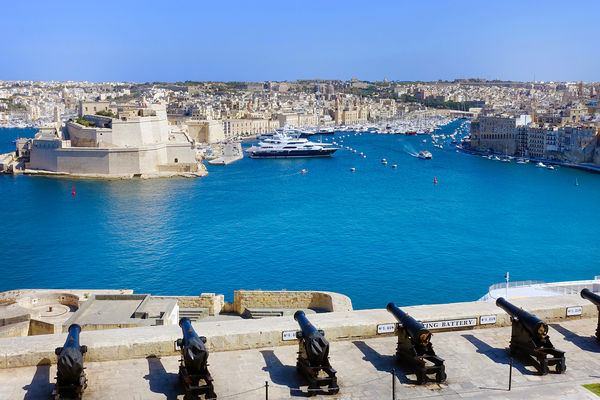Malta: A Citadel of Many Cultures in the Middle of the Mediterranean
By Rick Steves

Sailing into the stony harbor of the island of Malta, surrounded by ramparts and turrets, you realize that this strategic and much fought-over rock midway between Sicily and Africa has had a long and difficult history. But its parade of foreign rulers (Phoenician, Roman, Greek, Arab, Norman, Sicilian, and British — to name a few) make it a fascinating place to explore today.
The imposing capital city of Valletta is a monument to this hard-fought past. Government buildings seem to demand obedience. Walking on the ramparts of the heavily fortified harbor, I'm reminded of Malta's importance — whoever controls Malta controls trade routes across the Mediterranean.
Of the many cultures that shaped it, perhaps the most obvious is its British heritage. Malta spent 150 years as part of the British Empire. In World War II it was a key allied naval base before it was devastated by German bombs. (Much of it has been rebuilt in recent years.) And while it gained its independence in 1964, Malta retains its British flavor with English-style pubs and food, statues of queens, driving on the left, and even red phone booths.
Aside from its British vibe, Valletta has a distinct fortress-city feel, thanks to the Knights of St. John (a.k.a. the Knights of Malta). For centuries, these religious/military knights were based on the island of Rhodes in the eastern Mediterranean. In 1523 they were defeated by the Ottoman Turks, so they retreated to Malta, where they set up their new capital and built a huge fortress in anticipation of another Turkish attack. In 1565 Malta's stout walls — many of them incorporated into existing limestone cliffs — survived a siege of 40,000 Ottoman soldiers. Today, a good way to get a sense of this fortress city is with a tour of the harbor in a dgħajsa — a Maltese gondola.
From 1530 to 1798, the Knights of Malta ruled the island. During this era, known as the "Knight's Period," they ornamented the city with delightful architecture, including the colorful, characteristic enclosed balconies, called gallarija. The stately Grand Masters' Palace was one of the first buildings they constructed.
Another grand structure from this period is St. John's Co-Cathedral, one of Malta's two cathedrals. While austere outside, it's fabulously Baroque inside. Inlaid marble slabs honor several hundred Knights of Malta. This military order was divided into eight language groups — and each had a chapel here at the order's high church.
Paintings tell the 17th-century story of how the Knights were originally "serving knights," whose mission was to care for pilgrims venturing to the Holy Land, and how they later evolved into a military power with a mighty navy. They also depict how Christianity would ultimately "triumph" over Islam. A cathedral highlight is The Beheading of St. John the Baptist, the largest canvas ever painted by the artist Caravaggio, who fled Rome in 1606 after killing his opponent in a duel, eventually ending up in Malta.
Within a short drive (or bus ride) from Valletta are low-key sights, from charming towns with oversized churches and laid-back locals to tiny, remote harbors hiding out along the rugged coastline. The hillsides are studded with family farms — some with terraces that have been here since ancient times. The terraces' rock walls defend against erosion. Without them, the thin layer of topsoil would be lost to the steady Mediterranean wind.
The timeless landscape is dotted with prehistoric ruins dating back 5,000 years. Megalithic sites like Ħaġar Qim are evidence that, in roughly 3000 BC, settlers from Sicily arrived in search of arable land. While the humble, mud-brick village that once surrounded its temple is long gone, stones from the temple still stand. Archaeologists believe it was dedicated to a fertility goddess and that it functioned as a celestial calendar, much like Stonehenge. Artifacts from this and other prehistoric sites are housed in the National Museum of Archaeology in Valletta.
Near Ħaġar Qim is the fisherman's harbor of Marsaxlokk. A favorite with cruise travelers, it's home to a fleet of typical Maltese fishing boats. While Marsaxlokk has a fine main square and church, the action is along the harbor — especially during the Sunday fish market. The distinctive shape of the boats goes back eight centuries before Christ to when Malta was a Phoenician colony. These colorful boats pop in the dazzling sunlight, seeming to celebrate yet another unique heritage of the Mediterranean world.
As with any great Mediterranean destination, the cruise ship crowds may congest Malta's most famous attractions, but the rewards are great for those who understand some of the history of the place they're exploring and take the initiative to venture away from the crowds — to the lonesome stone circles, desolate castle ruins, and inviting back lanes.

